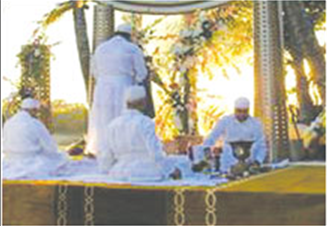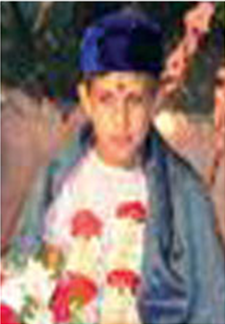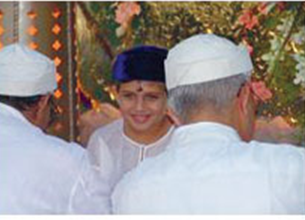Najvote ceremony for Parsis
This is a collection of articles archived for the excellence of their content. Readers will be able to edit existing articles and post new articles directly |
Najvote ceremony for Parsis
Entering the fold
By Rumana Husain
Najvote ceremony is held for Parsi children between the age of seven to nine to mark their initiation in the fold of Zoroastrianism
The invitation is for 5.00 p.m. We have been informed by the hostess that the Navjote ceremony will take place quite promptly as it must end at sunset. A small congregation has already assembled when we reach there. They are (mostly) family members of a young Parsi boy — Cyrus Cowasjee — for whose initiation rites we have gathered.
We join them — men and women dressed in smart suits and lovely saris — many of the saris have beautiful Chinese-style embroidery. We face a low stage, adorned with orchids and gladiolus and a small waterfall in the middle. Just behind the stage the Arabian Sea, glimmering in the late afternoon light, provides the perfect setting. A particular day is chosen beforehand by the family and the priests, who ensure that there is a full moon that evening.
We are informed by Cyrus’s grandfather that the child is going through a sacred ceremonial bath — and would be coming down for the ceremony any minute. Sure enough, in less than ten minutes he appears, escorted by his cheerful mother and aunt, as well as the officiating priest. Three other priests have already taken their positions on the stage before the arrival of the Navjote boy. All the priests are dressed in white.
Cyrus is made to sit before the High Priest, but his position on the stage is such that he mostly remains hidden from all of us as we can only see the back of the priest. Two of the other priests also have their backs towards the audience.
Now begins the serious business of the initiation prayers. As the occasion is an important one, and it marks a vital stage in the life of the child, it is looked at with all solemnity. Seven is the age at which it is enjoined to initiate a child, but the Navjote can be performed at any age between seven and nine.
A lit lamp has already been placed on the stage before the officiating priest, together with a new set of clothes for the child, including a new sacred shirt called Sudreh and a sacred string called Kusti. There is also a tray with grains of rice, a garland of flowers, coconut, raisins, and almonds, some betel leaves, betel nuts, a few pieces of sugar candy, etc. All of these are considered emblems of good luck throughout South Asia. Later, some of those things are sprinkled on the child as a symbol of prosperity. Also, there is a small fire burning with fragrant sandalwood and incense.
From what we can make out, the high Priest places in Cyrus’s hand the sacred shirt with which he is shortly to invest him. He then recites the Patet or the repentance prayer. The child repeats the prayer. At the conclusion of the Patet, the officiating priest gets up from his seat and makes the boy stand before him. Now follows the recitals of the Declaration of Faith by the child, the recital of the Nirang-i-kusti, or the Ahura Mazda Khodai prayer, the final recital of the Articles of Faith and then, finally, the recital of the Tandorosti prayer. The child is made to understand that the whole prayer (prayers are from the holy book called the Avesta), revolves around Maneshni, Gaveshni and Kuneshi, i.e. good thoughts, good words, and good deeds.
The bright orange-red sun is slowly disappearing in the water, and the priests have completed the entire ceremony. The joyful parents, grandparents, aunts, uncles and Cyrus’s little sister join him on the stage to embrace and wish him, but first the officiating priest and the other priests are paid their fees.
From now on, the young man may put on any dress he likes, but he must always wear the sacred shirt and the string as symbols of his religion. A Zoroastrian without the Sudreh and the Kusti is considered out of the fold and likely to fall into malevolence. After this formal initiation into the religion, he is himself responsible for offering prayers and observing religious customs and rites as a Zoroastrian.
The Sudreh is made of white mulmul or cambric. The white colour is symbolic of innocence and purity, thus the shirt is symbolic of purity of life and action of righteousness. The Kusti is made from sheep wool, and is also the emblem of innocence and purity, reminding a Zoroastrian of the purity of life and action which he must always observe. It is wrapped around the child’s waist thrice.
Zoroastrianism, at 3,500 years old, is one of the world’s oldest religions. Its practitioners worldwide follow the teachings of their Prophet Zoroaster. They left their homeland Persia —— now Iran —— in the 10th century to escape subjugation by Muslim conquerors. Many sought religious freedom in Western India, which is how Gujarati has become the language commonly used by the Parsi community.
Like a little dulha, the slightly dazed but beaming Cyrus is now standing on the stage with his parents, wearing a purple-coloured velvet cap. He is the centre of attention and affection. A sumptuous dinner has been laid out for the guests, but first they meet Cyrus to greet him and gift him a present in cash or kind.


